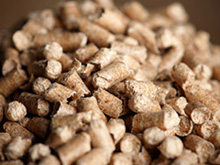Biomass and Biofuels

Biomass is a versatile energy source which can be used to provide domestic heating and fuel for a range of applications. Biomass is an organic matter and one of the most common forms of energy used on an international basis. Biofuels describe a wide range of fuels which are derived in some way from biomass.
Burning fossil fuels
The problem burning any fossil fuels which are based on carbon (such as coal, petroleum and natural gas) is that when they are burned they turn to carbon dioxide. The carbon dioxide (CO2) normally enters the atmosphere unless new high tech measures are utilised to capture and store it. This gives rise to increased concentrations of carbon dioxide in the atmosphere and the associated problems connected with it, for example global warming.
Burning Biomass fuel
The burning or combustion of biomass fuel does release carbon dioxide CO2 to the atmosphere. However, the difference with biomass is that it absorbed carbon dioxide whilst the plant grew over the previous few months or years. As long as the environment continues to support growing plant material, an ecological and sustainable balance is maintained between carbon emitted and absorbed.
Types of biomass energy materials
- Virgin wood, from forestry, related arboriculture activity or from wood processing
- Energy crops: high yield crops grown specifically for energy applications
- Food waste, from food and drink manufacture, processing and preparation, and post-consumer waste
- Industrial waste and co-products from industrial and manufacturing processes.
- Agricultural waste, by-products, residues from agriculture processing and harvesting
Wood is the most common source of biomass fuel, although many different materials can be used with increased availability.
How biomass applications can be used
There are a range of systems biomass can be used for including both domestic and commercial applications. Biomass energy can be used to fuel small stoves used in the home for heating, hot water or cooking up to extensive power plants used by centralized utilities to generate electricity.
More recent woodstove designs can improve the cooking or heating system efficiency, decreasing the amount of fuel that is needed. With wood burning stoves and biomass boilers reductions in carbon dioxide CO2 emissions are significant, approx 9 tonnes of carbon emissions per year can be saved when a wood boiler replaces a solid (coal) fired system.

 config
config view
view logs
logs 2048.0 KB
2048.0 KB



